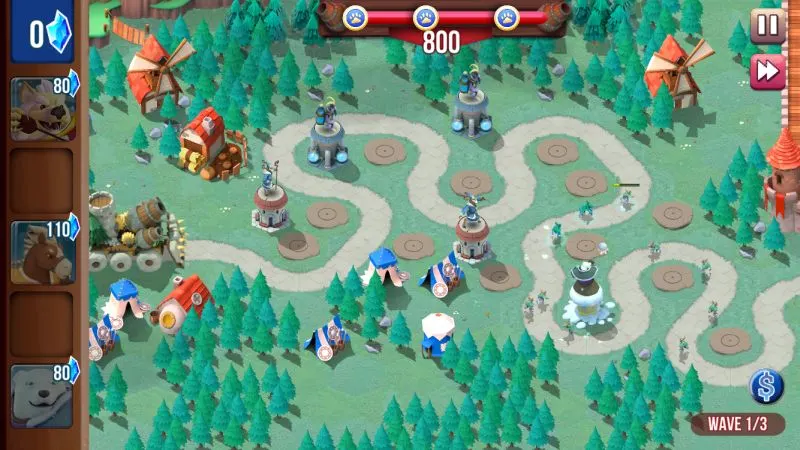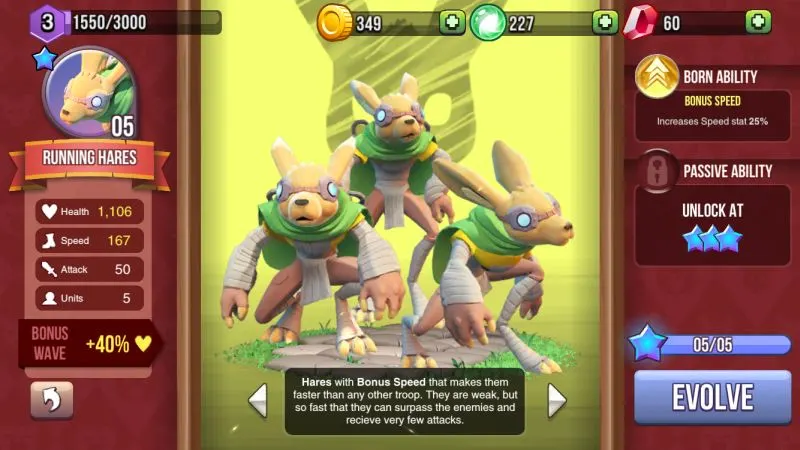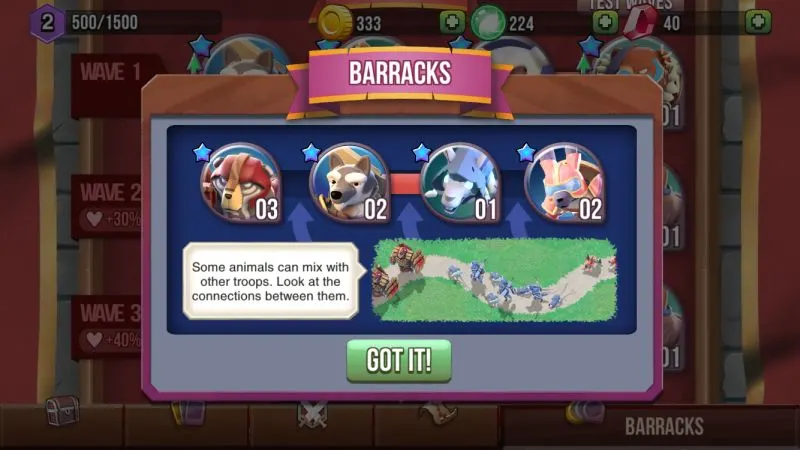Playstack Ltd is a company that’s released a variety of different mobiles games, including Snipers vs. Thieves, a first-person shooter game, Survival City, which is a zombie-themed game, and casual titles such as Ava Airborne, Cubiti Dash ’n’ Dodge, and Mowy Lawn. Their latest game covers yet another different genre – tower defense – and it’s called Wild Guardians, which is now available for iOS devices. It is mainly a PvP tower defense game where you can assemble an elite team of Guardians and fight off attacking monsters, choosing from more than 20 Guardians with over 45 abilities. You can create your own multiplayer maps and move up from one multiplayer league to the next as you earn bigger and better rewards, though you will also be able to play in campaign mode once you reach a certain level, ensuring that there’s something for all types of tower defense gamers. (Though we don’t see why you wouldn’t want to focus on anything else other than PvP…)
As is the case with other games in this genre, there’s a lot to cover in here, and that means we’re going to be starting out as we often do with a guide designed for the first-time players who may have downloaded the game a day or two ago, and may most likely be within the first three player levels. If that sounds like you, then by all means, keep on reading, because this is our Wild Guardians strategy guide for beginner players, which includes nine tips that cover the fundamentals of this new and interesting title.
1. Know The Basics

Wild Guardians is, in essence, a PvP tower defense game, and its basic gameplay, meaning setting up your towers and such, is not unlike games like Crazy Defense Heroes. You start out each level with a certain amount of mana per fight (in this case, it’s 400), and it’s your responsibility to budget that mana and set up towers across the battlefield while staying within the limit. As the battle progresses and you kill more enemy troops, you will earn more mana, and once you do, you can add more towers as you go along. But since this is a PvP game at its heart, that also means you will need to fight opposing players, and that’s where your Troops come in – your opponent sets up the towers, while your Troops step in and march toward the end of the path. Speaking of the end of the path, each enemy unit that crosses beyond that line will take its toll on your “health bar” on the top part of the battle screen – as we’ve seen, you start out with 800 and three stars (more on how stars work later on), and as each enemy reaches the end of the line and disappears from your screen, your health will progressively decline, and so will the number of stars. Reaching zero health means you lose the battle, but surviving it with at least some health remaining means that you win.
That’s pretty much the basic concept behind the battle system in Wild Guardians in a nutshell, but this is our very first tip – our customary explanation of the game’s basics – and we’ve still got a ways to go before we’re done with this guide.
2. Follow The Quests For Gems
There are three resources which you can collect in Wild Guardians – coins, which are the common currency, Plasma, which you can use to recruit troops (by purchasing chests) for your defense, and Gems, which are used to buy certain premium items, and stand out as the game’s premium currency. The best way to load up on gems, as you should have inferred by now, is by following the quests.
Like in most other games of this kind and in the RPG genre in general, completing the quests is the game’s way of making sure you’re moving in the right direction when playing. These quests keep you up to speed and ensure your goals are in line with whatever your current level is at the time. Just click on the exclamation point in the upper right portion of the main menu screen, and you’ll see what the next quests are – some may be easy, such as opening up a certain number of chests, while others may be difficult, such as the ones where you have to win consecutive battles with a perfect three stars. (As you’ll find out soon enough, winning with three stars can be quite the challenge in this game!)
3. Do Not Spend Those Gems On Speeding Things Up
This should be a standard tip for just about every game where you can spend gems to expedite certain tasks. But we’re going to mention it anyway, as this is, after all, a beginner’s guide. While the game will give you an option to pay gems to speed up the opening of a chest, you’re better off waiting, because there are so many things you can buy with your gems, including Premium Chests that may likely contain higher-end, rarer troops. Patience is the key here – we know that nobody loves waiting, but it’s also important to save up your premium currency for the things that could really help you move forward in this game.
4. Keep Fighting Battles To Level Up And Win More Chests
Although the game’s description makes mention of a campaign mode, all we’ve seen so far in this version of Wild Guardians is the main PvP mode. There are various types of chests which you can win in this game as a reward for completing and winning battles, and these include the standard chests, which usually come with 150 Gold and 100 Plasma inside. You can also get Two Medal Chests, which, as the explanation helpfully says, are rewarded whenever you win two medals in a single battle. Lastly, you also have your Star Chests, which can be opened once you’ve collected 10 stars at any given point in the game. There’s also a chest of sorts on the bottom right hand side of the main menu screen, and that actually isn’t a chest – it’s actually your Gold Wagon, which you can collect from every four hours or so, with a maximum of two chances to collect from it at any given time.

Obviously, both the chests and the Gold Wagon are great ways of earning more gold in the game, and when it comes to using that gold, you’ll mainly need it to level up your Guardians, who are the heroes in this game, and the ones represented in the different available towers. Leveling up Guardians allows you in turn to level up, as you’ll get an XP boost each time you upgrade one Guardian from one level to the next.
5. Take Time To Review Each Guardian’s Profile, And Level Them Up
By clicking on the Guardians tab (the second one from the left on the bottom menu), you can view all the Guardians you currently have unlocked at any given time. Each Guardian has a profile that details their individual stats and a brief biography, and that’s where you can see their strengths and weaknesses, their active and passive abilities, as well as their mana cost. All of the stats are relevant in one way or another, but it’s essentially their Damage and mana cost that would matter the most – review those stats carefully, because that’s going to help you choose your lineup of five for any given battle in the game!
The character screens will also allow you to upgrade, or level up your Guardians, and as we had previously mentioned, your coins will largely be going toward these upgrades. Just click on the Level Up button on the bottom right of the character screen, and you’re good to go – upgrading improves their stats, quite naturally, and once they reach a certain star rarity (which can be achieved by evolving them – more on that later), you’ll be able to unlock their passive ability as well!
6. Balance Of Damage And Mana
Building on what we had advised you in the above tip, it’s Damage and Mana that you should be focusing on mainly when you’re choosing your lineup of five. Mana costs are displayed on the upper right of the character avatar before you select a Guardian, while Damage is the topmost stat on all individual character screens. Obviously, you want to field characters, such as Sir Nimblehoof, who deal out a ton of damage against the enemy, but you also should be balancing that against their Mana cost – the aforementioned Nimblehoof, for instance, costs 110 mana to use in battle, and that’s quite a lot compared to the likes of Ulric and Troosh (80 each) and Brandt (50).
When it comes to Guardians who don’t cost much Mana, but are capable of doing a great deal of damage, Troosh would immediate come into mind. Not only does he deal out well more than 200 Damage and cost just 80 Mana units; he’s an AOE (Area of Effect) character, which means one blast could affect multiple enemy troops, all in one go!
7. Use Your Plasma To Buy Chests And Level Up Troops
Plasma is one of the basic resources in Wild Guardians, and you will mainly be using it to purchase chests in the store – one Basic Troops Chest costs 65 Plasma units each. Actually, that’s the only thing you can use your plasma on in the store at the present, though you will also be using your plasma to level up your Troops, who will be tasked to defend your cause and, well, simply survive as an opponent’s towers blast away at them.
It’s easy to overlook the Troops tab, but you can find this in the main menu, the fifth or rightmost button at the bottom of the screen. Once there, you can tap-and-hold to choose the troop composition for each of the three waves your opponents will need to survive. Make sure you tap on individual troops to view their health and other vital stats as well, and that you upgrade them whenever you’ve got some Plasma to spare! You’ll want to survive those blasts from enemy Guardians, so be absolutely sure you’re not neglecting your Troops.
8. How Does Evolution Work?

While we’re still on the topic of improving your Guardians and Troops, let’s move on to the topic of evolution, which is the process of upgrading a Guardian or a Troop from one star rarity to the next. For evolving a Guardian or Troop from one to two stars, you’ll first need to get them to level 5; once at level 5, the Evolve option will become available. Just hit the Evolve button, and you’ll be given a choice – sacrifice three other one-star rarity units, or spend a certain amount of gems. We would recommend the former option at first, as you should have no problem choosing units that may be surplus to your needs in the early goings. Things may get tougher, however, as you go on, as you may have fewer Guardians or Troops to sacrifice. Furthermore, there may be Guardians or Troops that you just might still be finding useful as a part of your offensive or defensive team. In which case, you can spend your Gems to perform the evolution without having to get rid of anyone.
9. Basic Tips For Planning Your Offense And Defense
Wild Guardians is a tower defense game that allows you to play both sides of the coin – you play defense actively as you set up towers to protect yourself against invading enemy troops, and you play offense passively, with your units marching through the path in three waves as your opponent does what they could to set up their defensive towers. What can we advise you when it comes to setting up your towers and planning your offensive waves?
When setting up towers, you want to cover as much ground as possible with your limited resources. Again, that’s only 400 Mana to start with, which would usually limit you to just four towers in most cases. Keeping that limit in mind, it’s best to space those towers and not bunch them all up together; doing the latter will concentrate the damage on specific parts of the map, but isn’t really all that practical, if you come to think of it. There’s no guarantee you’ll kill anyone by focusing your fire on that one area, and once the enemies escape the part you’re focusing on still in one piece, they’ll definitely make it to the end of the path and reduce your health, thus also potentially reducing your star count. The same applies if you’re focusing fire on the rear, and trying to take out all those waves before they reach the middle. It’s simply not going to work.
As for playing offense passively and planning out those waves, you will logically follow this pattern – start out with your squishiest Troops in the first wave then work your way toward your sturdiest Troops in the third wave. Damage is no longer the main stat you need to look at, as you’ll now need to look at their health points and determine which of your troops will take the longest to take out. Also be sure to test your waves out against your defenses – this is also a great way to practice your actual strategy, apart from seeing if your waves could withstand your opponent’s offensive towers. There are no stakes whatsoever involved here, so choose any configuration you wish, until you find the one that works the best for you.
